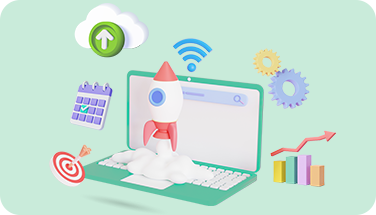What Is ERP? [A Beginner’s Guide]
ERP, or Enterprise Resource Planning, is revolutionizing back-office tasks for organizations in many industries, presenting modern solutions to help teams get the most from their everyday tasks.
In this blog, we will explore the basics of ERP, how it can help your organization, its components, benefits, and how it has changed over time.

What is ERP?
A definition of ERP can help us understand what the term refers to, but an exploration of what ERP does can help unpack the value of ERP and why it helps so many modern organizations achieve the outcomes they want.
ERP definition
ERP can simply be defined as a collection of software. ‘Enterprise Resource Planning’ (ERP) is an umbrella term describing several bits of integrated software an organization uses to run its day-to-day operations.
ERP can contain software for finances, human resources, procurement, project management, performance management, and more. By integrating business functions, they can share data easily, rather than exist independently, with the main goal of optimizing business operations.
What is an ERP system?
ERP software allows you to manage your people, money, and assets so you can easily control and analyze their data.
It doesn’t matter if you are a school, charity, service provider, consultancy, car dealer, or sales-based business, all organizations rely on money and people to operate. How an organization optimizes these two key resources will dictate its success.
ERP provides a modern data solution that gives you full transparency and visibility across all your people, finances, and projects, bringing ‘triple value’ to your organization.
Consider how people and money interact constantly throughout day-to-day business processes. ERP makes it easy to collect, organize, and distribute data.
When data is integrated and able to be viewed holistically, those in the C-suite can get an unrivaled understanding of data and its nuances which makes forecasting, reporting, and compliance, among other things, much easier.
Those organizations who have clear visibility of all their data, across business functions, can analyze this data and form strategies to continually optimize processes, leading to sustained growth.
Examples of ERP systems
There are two types of ERP deployment, on-premises hardware versus Cloud digital deployment.
However, the market share of public Cloud services is growing, while currently 42%, it is expected to increase by 15% over the next 5 years, with on-premises only growing by 4% - as reported by IDC.
The Cloud is paving the way for optimized ERP processes and shows significant capabilities and a pace of innovation that will eventually disrupt and eclipse on-premises ERP deployments.
Click to read ERP product brochure Gated
A brief history of ERP
The acronym ‘ERP’ was first coined in the 1990s by the Gartner group but was quite different from what exists today. ERP’s popularity in the 90s was the result of vendors capitalizing on the fear around the Y2K computing error.
The Y2K debacle showed that small IT errors and oversights could potentially be costly, and ERP was sold as the solution, providing businesses with a modern solution to IT that can build organizational resilience. Since then, on-premises ERP systems have grown in use, until the rise of the Cloud.
In the early noughties, large enterprises began to create ‘Cloud’ products, coining the term, and the age of cloud computing marked a new evolution within data management. The Cloud is now part of our everyday IT processes, and it soon became obvious that ERP could evolve greatly within the Cloud.
The latest chapter in the ERP story is integration with AI and automation, showing great prowess to increase productivity across operations, allowing many teams to refocus on strategic tasks, rather than data consolidation and management.
On-premises ERP vs. Cloud-based ERP
On-premises – Since ERP’s inception in the 1990s it took a physical operation to provide the computing power for ERP to function. Hardware was run on the company premises and large servers would be housed in the same building as employees.
This made ERP quite expensive, not just for the initial software license but for the actual hardware and the costs of maintenance. Moreover, if things went wrong a technician would have to be called out and physically tend to the hardware.
Cloud-based solutions – The Cloud is delivered by a ‘software-as-a-service’ (SaaS) model, this collaboration allows the network to operate digitally ‘in the Cloud’ rather than existing physically on your premises.
The Cloud has many benefits, but as the world has recently embraced remote and hybrid working the Cloud is becoming a necessity as well as an obvious solution to the issues physical hardware presents to compliance, maintenance, and sustainability.
The Cloud is an improvement on on-premises systems rather than an alternative, as Cloud capabilities can allow for automation, and AI, as well as much easier maintenance and cyber security.
As a result, customers with on-premises ERP systems will migrate for cost-savings among other benefits, while new customers will exist there immediately.
Key benefits of Cloud ERP
- Integration – When ERP lives on the Cloud, the data of key business functions becomes integrated. The functions can collaborate on reports, analyze data holistically, and more, providing a single source of truth to an organization, with the ability to gather data quickly.
- Automation – Using automation for low-level repetitive tasks, such as data entry and report generation, can help you optimize your employees' time better while also reducing human error. Teams can focus their energy on tasks that require a human touch, such as forecasting, data analysis, and people management.
- Collaboration – The Cloud creates a single source of truth for data, meaning business functions can naturally collaborate. Teams like HR and finance can easily communicate and share data, rather than being inhibited by legacy systems and siloed data.
- Accessibility – The Cloud can be accessed anywhere at any time thanks to its digital server. This means that remote and hybrid working environments are much easier to navigate as materials can be updated and accessed in real-time, from anywhere.
- Scalability – When your organization grows you will undoubtedly have more data management requirements. With on-premises, this can cost a lot to upgrade, whereas a Cloud solution can grow with you.
- Security – Cloud servers have a lot of security benefits over on-premises and legacy ERP systems. Major players like Microsoft have their own Cloud servers that are heavily monitored and even trusted by the government and other large enterprises.
Components of an ERP system
ERP consists of multiple components that seek to optimize common business processes and operations, though different vendors will cover different areas to suit different outcomes.
- Financial Management - Control every stage of your record-to-report cycle in a single, integrated, organization-wide system; consolidate all your data, for full control and visibility at any time, from anywhere.
- Project Management - Give your teams a complete solution for managing the entire project cycle from project creation to final invoice and project closedown. ERP can help record project data so your future projects can be optimized, which is tough without data visibility.
- Core HR – With a robust core HR system, you can manage and analyze your workforce with a centralized database to record and monitor employee data, while reducing the burden of administrative tasks.
- Procurement Management - Regulate costs and streamline processes for every stage of the purchasing cycle through contract management, purchasing, order fulfillment, and invoice reconciliation and payment.
Who is ERP for?
One other misconception is that ERP is only for large enterprises. This isn’t the case, as ERP can benefit all kinds of organizations of different sizes in different ways.
- Large-scale enterprises – Large-scale enterprises can often have a lot of complexities. Whether that’s managing finances and HR across international subsidiaries or simply having larger compliance pressures on them, digital transformation with an ERP suite can help consolidate this complexity and unite teams.
- Small-to-medium-sized enterprises – Some smaller enterprises may presume that an investment in ERP would give diminishing returns, but there’s a lot to gain. Smaller enterprises can scale a lot more easily with ERP on the Cloud, build organizational resilience, and get the upper hand on competition with streamlined back-office operations.
No matter the size of your organization, ERP software has many applications across different industries, including:
- Public Sector – Public sector organizations have a lot to gain from Cloud ERP. Many of these organizations have many back-office processes entrenched in legacy systems. The public sector can improve productivity by moving to ERP, whether that is a city council, charity, or private institution.
- Professional service firms – Service-based firms can reduce the work of their finance teams and find a better HR experience with an ERP suite. Whether that’s a consistent and efficient invoicing system, using their current staff optimally, or building better procurement practices, they can improve their bottom line.
- Nonprofit organizations – Nonprofits, perhaps more than other organizations, must focus on boosting productivity and generally streamlining their operations so that they can meet historical backlogs as well as today’s demand. ERP software can ensure compliance, better reporting to stakeholders, donor tracking, and efficient use of budgets.
- Higher Education – Higher Education is another industry under constant demand and is continually looking to optimize its back-office operations and costs. It’s vital to make the best use of academic and staff time, maximize funding, and ensure your technology doesn’t hold back growth or investment opportunities.
How Unit4 can help you digitally transform your operations
Choosing an ERP provider is its own challenge, but at Unit4 we put people first and ensure implementation is succinct and simple. You can see our suite of Cloud-based ERP solutions on our website where we break down the benefits and use of each product in our blogs.
Alternately you can hear from industry researchers, as well as our happy customers, who provide testimony and stories of how we helped onboard ERP in organizations of all sizes.
Frequently Asked Questions
How does an ERP system benefit an organization?
An ERP system integrates data from various business functions into a single source truth, making it easier to manage and analyze. This integration provides full transparency and visibility across people, finances, and projects, which enhances forecasting, reporting, and compliance.
How does Cloud ERP improve security?
Cloud ERP solutions are often hosted by major Cloud providers, like Microsoft Azure, who offer enhanced security measures and constant monitoring from their own internal security teams. These providers have extensive resources to ensure data security, often exceeding the capabilities of on-premises systems.
Why should I migrate from on-premises to Cloud-based ERP?
Organizations might migrate to Cloud-based ERP for several reasons, including integrated data, cost savings, improved maintenance, enhanced scalability, and the ability to leverage AI and automation for increased productivity.
What factors should be considered when choosing an ERP provider?
When choosing an ERP provider, consider the ease of implementation, the specific benefits and use of their products, customer testimonials, and the support provided during the onboarding process. Unit4, for example, emphasizes a people-first approach and offers a comprehensive suite of Cloud-based ERP solutions.





